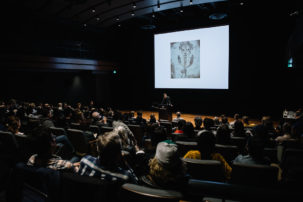Have you ever wondered how Canada’s most successful cultural workers landed their jobs? Getting a dream gig starts with developing great skills and a great attitude. In order to make yourself a commodity in the art world, it’s important to get practical experience, and then to demonstrate how that experience relates to the position you’re applying for. Below, Mary Reid—a teacher and lecturer, and the curator of contemporary art at the Winnipeg Art Gallery—explains how to gain the experience that will make your resumé stand out.
Career Objective
First, think about the sort of job you’re qualified for—and eager to perform. “Somebody with a journalism and communications background can be a marketing and communications coordinator,” says Reid. Alternatively, she adds, “somebody who is interested in databases and inventory control can go in collections management and registration, while someone who has an interest in education can become an arts educator.” Emphasizing the diversity of potential jobs in the cultural sector, Reid insists that “there are lots of opportunities for people who are interested in the arts.”
Qualifications
Once you’ve decided what you want to do, try to develop the qualifications that will prepare you for the job. As Reid notes, critical thinking skills are invaluable in creative positions: “It’s about looking at whatever is in front of you, and thinking about why you’re looking at it—what is eliciting your response, how is it made, who made it, where it is being presented and what the context is.”
Reid suggests that well-developed research skills are also an important asset. “A lot of people will take a subject and dig way down very deeply, which is good,” she says, “but I think what’s important is surveying the archive,” explaining that analysis is just as important as gathering information. Finally, Reid notes that cultural-sector employers seek out organized, efficient individuals. Working in the arts, she says, “isn’t a nine-to-five job, it’s a lifestyle.” You’ll be working long hours and juggling multiple responsibilities, so you have to have a system that works for you, for keeping track of everything.
Education
Completing an arts degree or enrolling in courses will help prepare you to work in the cultural sector. Besides taking classes in art-making and art history, look into courses that will broaden your overall knowledge and give you skills you’ll need. Reid recommends taking a business course, for example, or developing fluency in French.
Volunteer Experience
By volunteering for local organizations, you will gain beneficial experience while also getting the chance to network. “Particularly in smaller organizations, there’s never enough money or enough time to do everything,” says Reid. “So it’s a good idea to volunteer your time and say you want to work with the curator, the registrar, the conservator, whoever you want.” Come in often—say, one afternoon a week—and really get involved in projects. You’ll gain valuable contacts and recommendations. Plus, when a contract or a job becomes available, you’ll be the first to know, and you’ll be interviewed by people who already know you.
Professional Development
The truly successful cultural worker always endeavours to grow—as a person and as an employee. Reid recommends seeking out chances to try new things, and considering the options that fall into your lap. The more you go to conferences and introduce yourself to colleagues—and follow up by sending a catalogue you contributed to or offering to write a review—the more opportunities will present themselves.

 OCAD University, photography area, digital facilities. Courtesy OCADU/ Darren Cerkownyk
OCAD University, photography area, digital facilities. Courtesy OCADU/ Darren Cerkownyk







